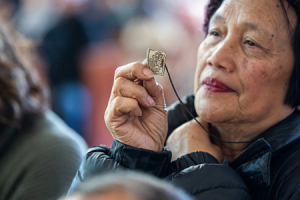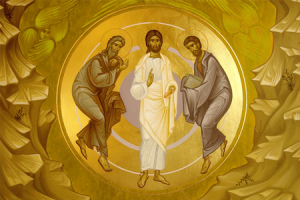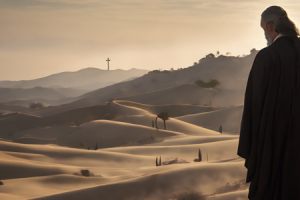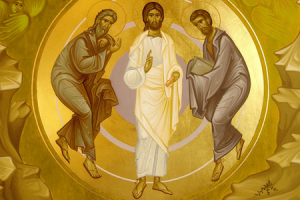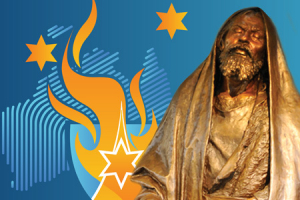Wenty celebrates Our Lady of Mt Carmel
Transfiguration
The Gospels of the first 2 Sundays in Lent tell us what Lent is about and what Christian life is about: a journey from temptation and doubt to transfiguration and faith.
Come back to me with all your heart
Transfiguration
This Sunday’s Gospel of the Transfiguration completes the ‘little parable’ formed by the Gospels of the first two Sundays of Lent.
default
Celebrating At Home 2nd Sunday in Lent [PDF]
default
Celebrating At Home 2nd Sunday in Lent [ePub]
Feast of Elijah, the Prophet
On 20 July Carmelites throughout the world celebrate the Solemnity of the Old Testament Prophet, Elijah. In the Carmelite tradition Elijah is regarded as the spiritual father of and a source of inspiration for Carmelites.
We need the spirit of Elijah
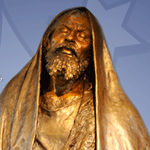 At a recent Papal Audience, Pope Francis said, "We need the spirit of Elijah" and described him as “one of the most compelling characters in the whole of Sacred Scripture.” Carmelites regard Elijah as our spiritual father, so Pope Francis' words about him resonate deeply with us.
At a recent Papal Audience, Pope Francis said, "We need the spirit of Elijah" and described him as “one of the most compelling characters in the whole of Sacred Scripture.” Carmelites regard Elijah as our spiritual father, so Pope Francis' words about him resonate deeply with us.
Focusing on Elijah’s prayer life, Pope Francis underlined how prayer and contemplation sustained the Prophet not only in moments of great success but also in the face of adversity and persecution. Read more & see video.
Feast of Elijah, the Prophet
 Today Carmelites throughout the world celebrate the Solemnity of the Old Testament Prophet, Elijah. In the Carmelite tradition Elijah is regarded as the spiritual father of and a source of inspiration for Carmelites.
Today Carmelites throughout the world celebrate the Solemnity of the Old Testament Prophet, Elijah. In the Carmelite tradition Elijah is regarded as the spiritual father of and a source of inspiration for Carmelites.
From Elijah, Carmelites learn to be people who stand before God
with undivided heart, entirely dedicated to his service,
and aflame with a passionate love for God and others.
Solemnity of Elijah, the Prophet - 20 July
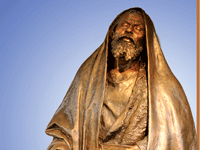 On 20 July Carmelites throughout the world celebrate the Solemnity of the Old Testament Prophet, Elijah. In the Carmelite tradition Elijah is regarded as the spiritual father of and a source of inspiration for Carmelites.
On 20 July Carmelites throughout the world celebrate the Solemnity of the Old Testament Prophet, Elijah. In the Carmelite tradition Elijah is regarded as the spiritual father of and a source of inspiration for Carmelites.
From Elijah, Carmelites learn to be people who stand before God
with undivided heart, entirely dedicated to his service,
and aflame with a passionate love for God and others.
Elijah gets a makeover!
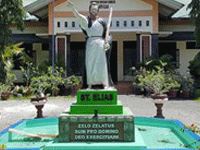 The statue of the Prophet Elijah in front of our house in Hera, Timor-Leste, was given a makeover by our Carmelite students during the summer holidays. Fresh coats of paint and a water feature surrounding the statue were added with stunning effect.
The statue of the Prophet Elijah in front of our house in Hera, Timor-Leste, was given a makeover by our Carmelite students during the summer holidays. Fresh coats of paint and a water feature surrounding the statue were added with stunning effect.
The project was the brainchild of Fr Carlito Da Costa Araujo and Br Frangelino Ximenes, who also supervised the work. Fish have since been added to the water feature.
Feast day Greetings - Solemnity of the Prophet Elijah
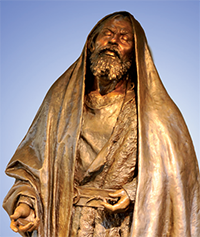 Today is the Solemnity of the Prophet Elijah. Carmelites look to Elijah as an inspiration for their way of life.
Today is the Solemnity of the Prophet Elijah. Carmelites look to Elijah as an inspiration for their way of life.
The first Carmelites settled on Mount Carmel in Palestine near the spring of Elijah. It was on Mount Carmel where Elijah challenged the people to stop hobbling first on one foot and then on the other but to choose who is God in Israel - Yahweh or Baal. According to the story, which can be found in the First Book of Kings, chapter 18, Elijah's sacrifice was consumed by fire from heaven which proved to the people that Yahweh was the true God.
Elijah made himself available for God's work and was sent into various situations to proclaim God's word. On Mt Horeb God became present to Elijah, not with the signs usual in the Old Testament of fire, earthquake and mighty wind, but in the sound of a gentle breeze.
From Elijah, Carmelites learn to listen for the voice of God in the unexpected and in silence. We seek to allow the Word of God to shape our minds and hearts and to become channels of God’s tender love for all.
National Shrine of Our Lady of Mt Carmel
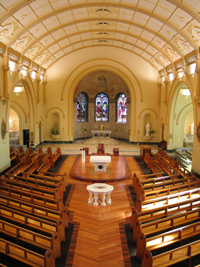 The National Shrine of Our Lady of Mount Carmel is located at the corner of Richardson and Wright Streets in Middle Park, Victoria, Australia.
The National Shrine of Our Lady of Mount Carmel is located at the corner of Richardson and Wright Streets in Middle Park, Victoria, Australia.
This Church of Our Lady of Mount Carmel was begun in 1912 and completed in 1928. It was dedicated as the National Shrine in 1944 and has been home to the Carmelite family in Australia since then.
Throughout the year special events are held at the Shrine during which we pray for the members of our Carmelite family and their needs.
These masses include the
- Mothers' Mass, celebrated on the Feast of Our Lady of Mount Carmel
- Mass of Remembrance, celebrated near to All Souls Day and All Saints Day
- Thanksgiving Mass, celebrated at midnight on Christmas Eve
The Church contains shrines to:
- Our Lady of Mount Carmel
- St Therese of Lisieux
- St Mary of the Cross Mackillop
- The Prophet Elijah
- The Sacred Heart
and is open 8.30-9.30am Tuesday, Thursday & Saturday mornings and 4.30-6.00pm Saturday evenings & 10.00am-12.00pm on Sundays.
For more information about how you can be part of these special events please contact the This email address is being protected from spambots. You need JavaScript enabled to view it.
History of the Carmelite Order
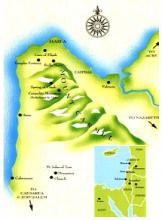 Origins & growth
Origins & growth
The Order of Carmelites has its origins on Mount Carmel, in Palestine, where, as we read in the first Book of Kings, the great prophet Elijah defended the true faith in the God of Israel, when he won the challenge against the priests of Baal. It was also on Mount Carmel that the same prophet, praying in solitude, saw the small cloud which brought life-giving rain after the long drought. From time immemorial, this mountain has been considered the lush garden of Palestine and symbol of fertility and beauty. Indeed, "Karmel" means "garden".
In the 12th century (perhaps after the third crusade, 1189-1191), some pilgrims who had come from Europe, came together near the "spring of Elijah", in one of the narrow valleys of Mount Carmel, to live out their Christianity as hermits after the example of the prophet Elijah in the very land of our Lord Jesus Christ. Then and in later times, the Carmelites did not acknowledge anyone in particular as their founder, but remained faithful followers of Elijah who was associated with Mount Carmel through biblical events and through Greek and Latin patristic tradition which saw in the prophet one of the founders of the monastic life. In the middle of the cells they built a chapel which they dedicated to Mary, Mother of Jesus, thus developing a sense of belonging to Our Lady as Patroness, and they became known by her name as "Brothers of Saint Mary of Mount Carmel". Thus Carmel is deeply associated with Elijah and Mary. From Elijah the Carmelites inherited a burning passion for the living and true God and the desire to make His Word intimately their own in order to witness to Its presence in the world; with Mary, the Mother of God, they are committed to live "in the footsteps of Jesus Christ" with the same intimate and deep feelings which were Mary's.
In order to have some juridical stability, this group of lay hermits turned to the Patriarch of Jerusalem, Albert Avogadro (1150-1214), who was then living at St John of Acre near Mount Carmel. Between 1206-1214, Albert wrote for them a formula of life. Successive approvals of this formula of life by various Popes helped the process of transforming the group into a Religious Order, a fact which took place at the time of the definitive approval of the text as a Rule by Innocent IV in 1247. Thus the Carmelite Order took its place alongside the Mendicant Orders.
However, about 1235, the Carmelites were forced to abandon their place of origin due to the incursions and persecutions of the Saracens who were reconquering the Holy Land from the crusaders. Most of them went back to their country of origin in Europe.
Soon they increased and flourished in the sciences and in holiness. Later some women attached themselves to the monasteries of the friars and in 1452 became cloistered nuns living in their own communities.
Reform & development
In the 15-16th centuries there was some relaxation of discipline in various communities, a fact greatly opposed by Priors General such as Blessed John Soreth (+1471), Nicholas Audet (+1562) and John Baptist Rossi (+1578), and by some reforms (among others those of Mantua and Monte Oliveti in Italy and of Albi in France) to put a stop to the spread of the abuses and the mitigations. The most famous reform is certainly the one started in Spain by St Teresa of Jesus for the reform of the nuns and then, helped by St John of the Cross and Fr Girolamo Gracian, for the reform of the friars. The most relevant aspect of this reform of Teresa is not so much that she opposed the mitigations introduced in the life of Carmel, but rather her ability to integrate in her project, vital and ecclesial elements of her time. In 1592 this reform, called that of the "Discalced Carmelites" or of the "Teresians", became independent from the Carmelite Order and grew rapidly in the congregations of Spain and Italy which were then united in 1875. Thus there are two Orders of Carmelites: "The Carmelites", also known as of the "Ancient Observance" or "Calced", and "The Discalced Carmelites" or "Teresians" who consider St Teresa of Jesus their reformer and foundress.
In spite of this division, during the following centuries the Carmelite Order continued its spiritual journey. Many illustrious men and women gave new spirit to Carmel with their own spirituality and genius. There was also significant development among the laity with the institution of the Carmelite Third Order and the Confraternities of the Scapular of Our Lady of Mt Carmel throughout the world. With the Reforms of Touraine in France, and of Monte Santo, Santa Maria della Vita, Piedmont, and Santa Maria della Scala in Italy, in the XVII and XVIII centuries the movement for a stricter observance spread everywhere.
At the dawn of the French Revolution, the Carmelite Order was established throughout the world with 54 Provinces and 13,000 religious. But as a result of the French Revolution the Order suffered great losses, such that at the end of the 19th century it was reduced to 8 Provinces and 727 religious. But it was this small band of religious who during the 20th century, with determination and courage, re-established the Order in places where it had been and also planted the Order on new continents.
The Carmelite Order today
Since the time of the Second Vatican Council (1962 - 1965), Carmelites have reflected at length on their identity, on their charism, on what is fundamental in their lives and what is for them a "life-project", namely "to live a life of allegiance to Jesus Christ and serve him faithfully with a pure heart and a good conscience" (Rule). They found their allegiance to Christ in their commitment to seek the face of the living God (contemplative dimension), in living in fraternity and service (diakonia) in the midst of the people. They see all this in the lives of the prophet Elijah and the Blessed Virgin Mary who were led by the Spirit of God. Looking at Mary and Elijah, it is easy for the Carmelites to understand, to interiorise, to live and to announce the truth that makes a person free.
Carmelites, conscious of being part of the Church and of history, live in a fraternity that is open to God and to people, able to listen and give an authentic response to the evangelical life according to their own charism, and they commit themselves to build the Kingdom of God wherever they are. Indeed they are committed to evangelisation in houses of prayer, centres for spiritual exercises, parishes, Marian sanctuaries, schools, religious associations; and to Justice and Peace wherever human dignity is trodden underfoot, especially among the poor, the marginalised, the suffering.
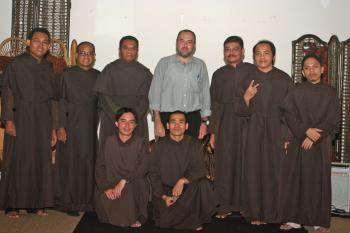 To this vast and varied challenge of the Carmelite friars, one will find in close collaboration: communities of cloistered nuns, Congregations of sisters, Consecrated Lay people, numerous groups of Third Order Lay members and Confraternities of the Scapular of Our Lady of Mt. Carmel. All these groups, born of the Spirit throughout the centuries, and inspired by the Carmelite Rule are intimately united by the bond of love, of spirituality and of the communion of spiritual goods. They constitute the Carmelite Family in the Church. At present the Carmelite Order (the friars) is formed of Provinces, General Commissariats, General Delegations, Hermetical Communities and an Affiliated Community with a total of about 2,000 religious. They are found in all the continents.
To this vast and varied challenge of the Carmelite friars, one will find in close collaboration: communities of cloistered nuns, Congregations of sisters, Consecrated Lay people, numerous groups of Third Order Lay members and Confraternities of the Scapular of Our Lady of Mt. Carmel. All these groups, born of the Spirit throughout the centuries, and inspired by the Carmelite Rule are intimately united by the bond of love, of spirituality and of the communion of spiritual goods. They constitute the Carmelite Family in the Church. At present the Carmelite Order (the friars) is formed of Provinces, General Commissariats, General Delegations, Hermetical Communities and an Affiliated Community with a total of about 2,000 religious. They are found in all the continents.
About the Lay Carmelites
Since our beginnings in the 13th century, Carmelites have sought to follow Christ in a fraternal community united in a spirit of contemplative prayer and our desire to be of service to God and to the people among whom we live. The Lay Carmelites are just what the name implies: lay men and women who form an integral part of the Carmelite family and try to live out the Carmelite way of life in the ordinary circumstances of our family and social life.
Mary and Elijah
As we attempt to follow Christ more closely, we Carmelites find inspiration in the Old Testament Prophet, Elijah, and in the Blessed Virgin Mary.
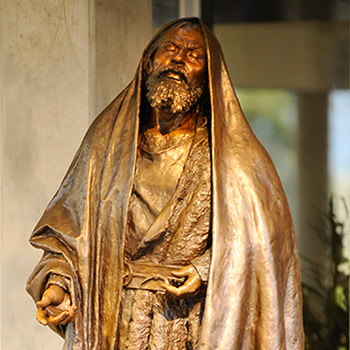 The Prophet Elijah
The Prophet Elijah
Elijah's memory was kept alive especially on Mount Carmel where he challenged the people to stop hobbling first on one foot and then on the other but to choose who is God in Israel - Yahweh or Baal. According to the story, which can be found in the First Book of Kings, chapter 18, Elijah's sacrifice was consumed by fire from heaven which proved to the people that Yahweh was the true God.
Elijah in the presence of the Lord on Mount Horeb
Elijah made himself available for God's work and was sent into various situations to proclaim God's word. Elijah undertook a long journey through the desert where he began to despair. He sat down under a bush and wished he were dead but God would not allow him to die and prodded him to continue his journey to Mount Horeb. When he arrived there, God became present to Elijah. God came not with the signs usual in the Old Testament of fire, earthquake and mighty wind but in the sound of a gentle breeze. Elijah was sent back to his people to carry out God's will.
From Elijah, Carmelites learn to listen for the voice of God in the unexpected and in silence. We seek to allow the Word of God to shape our minds and our hearts so that the way we live and the things we do may be prophetic and therefore faithful to the memory of our father Elijah.
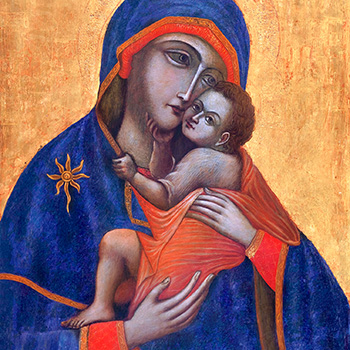 The Blessed Virgin Mary
The Blessed Virgin Mary
The first hermits on Mount Carmel built a church in the middle of their cells. This was the centre of their lives where they converged each day to celebrate Mass together. This little church they named in honour of Our Lady. By this fact the first group of Carmelites took her as their patroness, promising her their faithful service and expecting her protection and favour. They were proud to bear the title of "Brothers of the Blessed Virgin Mary of Mount Carmel" and they defended this title with vigour when their right to it was challenged.
Mary ever ready to accomplish the wish of God
Mary consented to God's will when she was asked to be the mother of the Saviour. She pondered on the events of her life and was able to see in them the hand of God at work. Mary did not become proud about her unique vocation but instead praised God for looking on her lowliness and doing great things in her. She was with Jesus at the beginning of his public ministry when, at the marriage feast at Cana, she made known to him the simple need, "They have no wine". She was with him as he died and there she became the mother of all believers. At the beginning of the Acts of the Apostles we find Mary gathered in the upper room praying with the other disciples waiting for the outpouring of the Holy Spirit. For us Carmelites, Mary is a constant presence in our lives, guiding us and protecting us as we seek to follow Christ.
The brown scapular has for many centuries summed up the Carmelite's relationship with Our Lady. The scapular is a piece of cloth based on the traditional Carmelite friar's garb. Wearing the scapular is a sign of consecration to Mary, the Mother of God, and is a symbol showing that the person is putting on the virtues of Mary and is being protected by her.
Mary symbolises for the Carmelite everything that we hope for - to enter into an intimate relationship with Christ, being totally open to God's will and having our lives transformed by the Word of God. Carmelites have always thought of Mary as the Patroness of the Order. We seek to live in spiritual intimacy with her so that we can learn from her how to live as God's children.
Elijah and Mary are inspirational figures for all Carmelites. They play a very important part in the life and spirituality of the Order which sees itself as belonging to Mary and looks to Elijah as our spiritual father.
The Carmelite Story
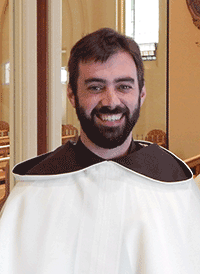
We do not know exactly when the forbears of the Order of Carmelites first came to Mount Carmel: it was around the year 1200 AD. They settled in a small valley on the western slope of the mountain, near a spring known since antiquity as the "spring of Elijah".
The Carmelites shared many of the spiritual aspirations of the hermits and pilgrims in the Holy Land at the time of the Crusades: the commitment to poverty and simplicity of lifestyle, their desire for spiritual freedom, their intimacy with the Scriptures and their longing to hear the Word of God in the quiet of solitude, the central place given to love, their wish to build a brotherhood in which they could learn to see Jesus in each other.
These values continue to inspire Carmelite life today.
The Carmelite travels the most demanding journey of all … the journey inwards into one’s own heart.
As Prophetic Contemplatives …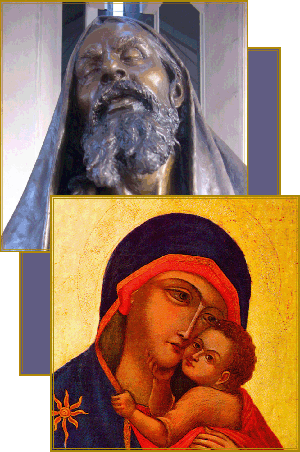
Carmelites find inspiration in the persons of Elijah, prophet of Mount Carmel, and Mary, the first disciple of the Lord.
Like them, Carmelites create an open space in themselves in order to recognise God, and so embark on the most demanding of all journeys, the journey into one’s own heart. As prophets they are called to share this experience of God with all people.
In Ministry …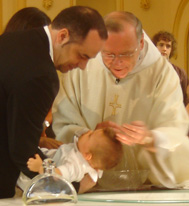
Carmelites work in many and varied ways … Welcoming people to participate in their life and spirituality in…
parish life hospitality education & formation
spirituality ministry communications retreat work
 Through Our Life Together…
Through Our Life Together…
Carmelites are called to share their commitment to Christ within a community.
They live a common life — sharing their time, their income, their wisdom, their talents, their prayer. The way of poverty, chastity and obedience offer great freedom to live life fully.
Download our pdf vocations brochure.
Finding out what God wants – Discerning My Personal Vocation
Discernment is experiencing with understanding and commitment
the presence and guidance of God in my whole life….
Ernest Larkin, O.Carm
For further information please contact:














